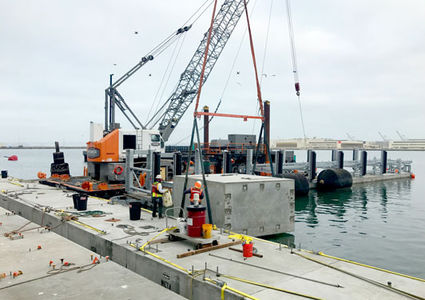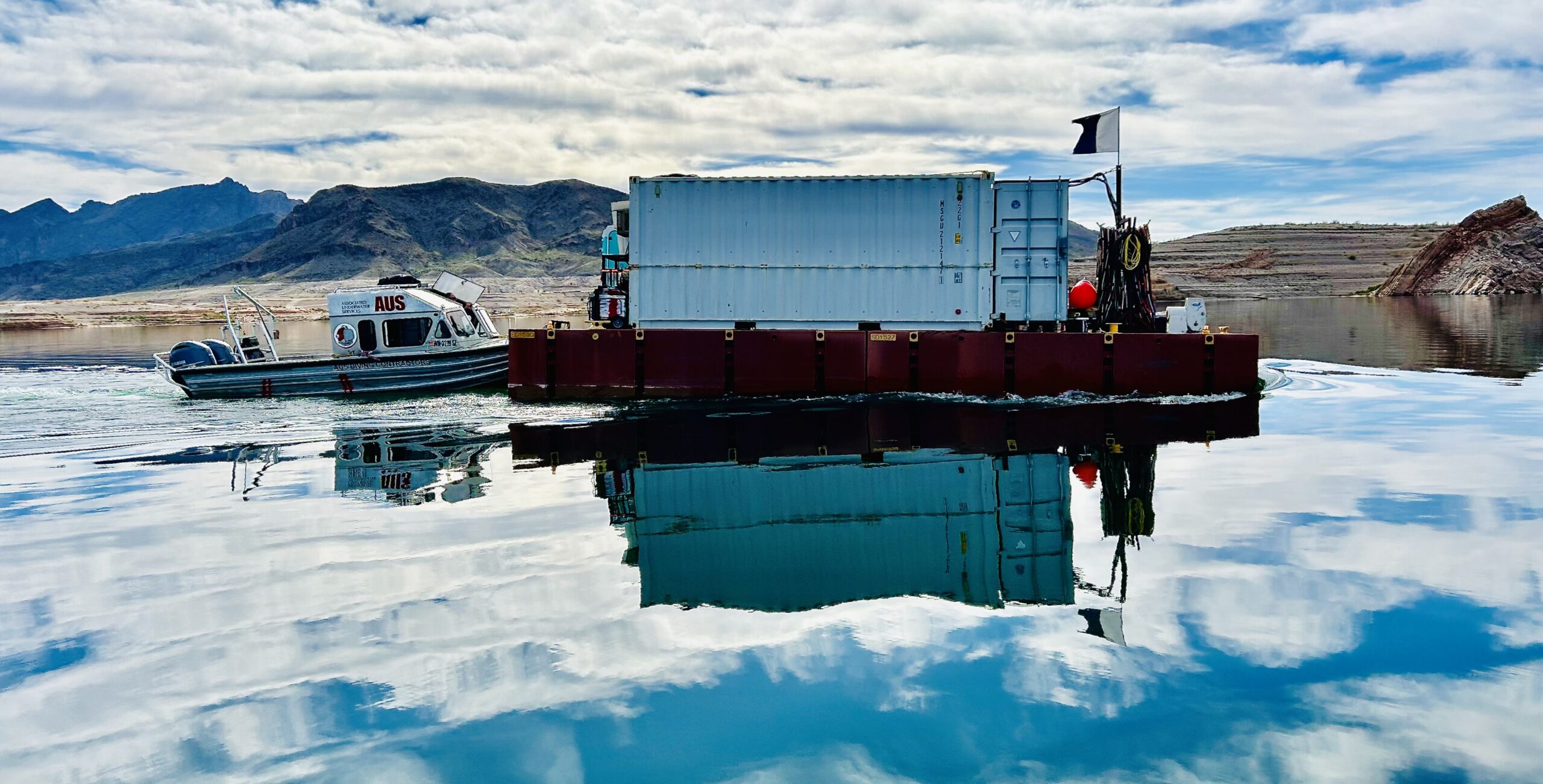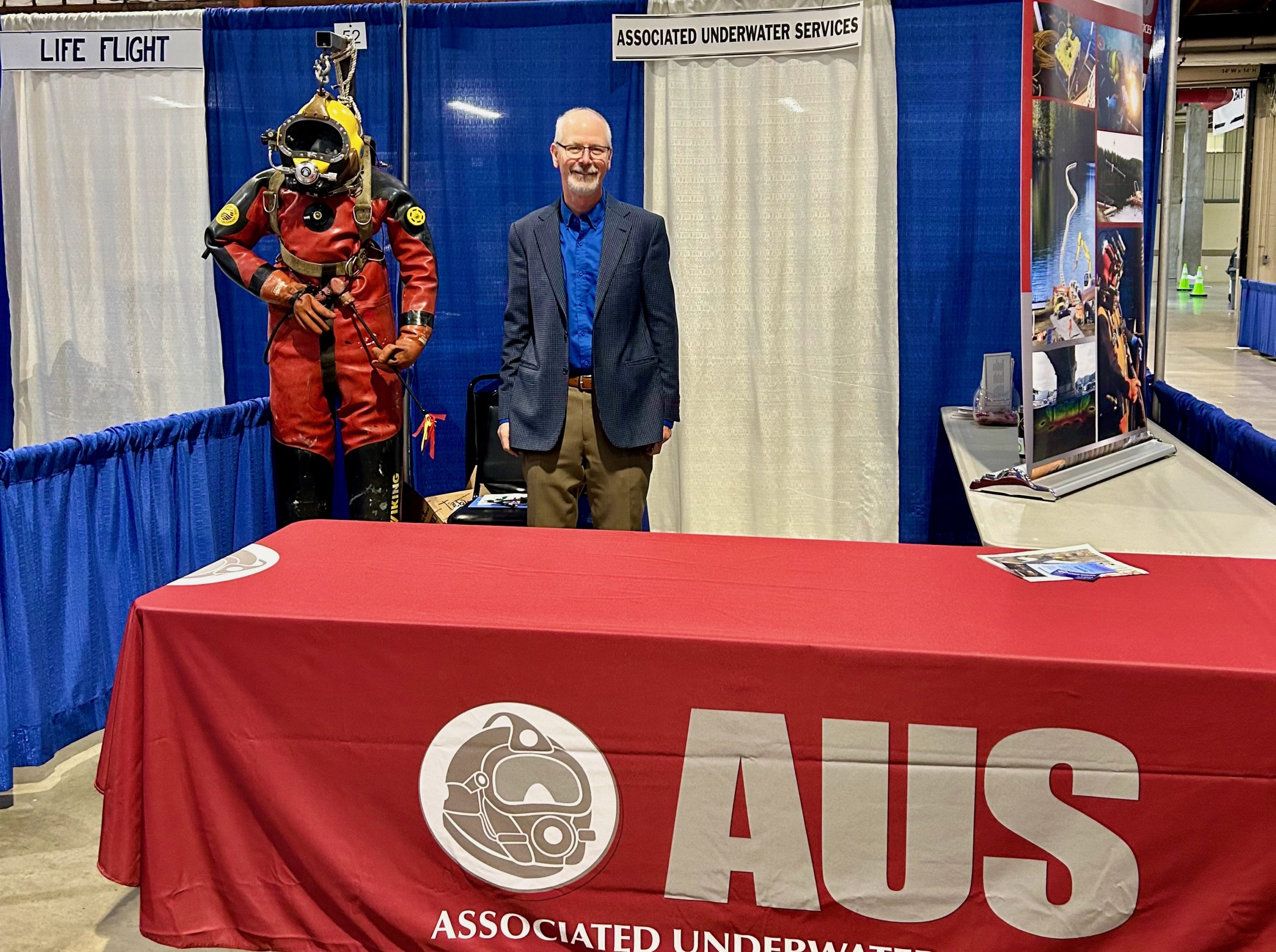June 1, 2018 By Kathy A. Smith Originally posted here: https://www.pacmar.com/story/2018/06/01/features/marine-construction-projects/616.html

The WETA Central Bay Operations & Maintenance Facility main float walkway extends more than 450 feet offshore with 6 finger floats each extending 134 feet perpendicular to the main. Photo courtesy of WETA.
Marine Construction companies have been busy over the past year, building new over-water facilities, upgrading existing infrastructure and demolishing structures that no longer serve a useful purpose.
Spokane, Washington-based AUS Diving has been occupied with a number of marine maintenance projects. Earlier this year, the company completed the installation of a dewatering bulkhead for the replacement of a generator on the Northwestern Energy-owned Hauser Dam in Montana.
The site is on the Missouri River, located approximately 14 miles northeast of Helena. AUS installed the bulkhead, which required rock/debris removal, drilling and installation of epoxy anchors, and grouting of the base plate. The four-man team dove in temperatures as low as 15 below zero.
In contrast, a six-man crew from AUS has faced nearly 110-degree temperatures working on an anchor and cable replacement project at Pleasant Harbor Marina & RV Resort in Lake Pleasant, Arizona. The 500-slip marina is comprised of several docks that include a restaurant, boat rentals, fuel dock, and private moorages. AUS was called in to perform an underwater inspection. Afterward, it was determined that approximately 200 anchors and cables that hold the marina in place, needed to be upgraded.
Working at depths ranging from 40 to 200 feet is challenging. Doing this safely with a high volume of boat traffic coming and going from the marina requires constant monitoring. The site area is set up with marker buoys, and the 30-foot by 50-foot barge also has placards warning boaters to stay clear.
“With such a busy marine traffic area, diver and boater safety is important,” said general manager, Kirk Neumann. A 15-ton crane positioned on the barge, as well as a 50-ton winch, are being used to handle the 17,000-pound concrete anchor blocks. AUS has an ROV on site to help limit diving and using GPS for positioning and tracking the anchors accurately. The project began in the summer of 2017 and is expected to be completed by the end of summer 2018.
Closer to home, AUS is working on a cable replacement project on the I-90 bridge that runs across Lake Washington between Seattle and Mercer Island. The project was contracted out by the Washington State Department of Transportation. American Bridge is the main contractor. WSDOT identified 32 cables that require replacing. AUS’ dive team is working from the waterline down to 230 feet of water.
Diving at depth requires mixed gas (helium and oxygen). Following each dive, the divers must undertake substantial decompression in a decompression chamber. “We have two chambers on the barge. And we have our SeaEye Falcon ROV also on the project,” said Neumann.
The cables will be de-tensioned from the bridge. Each cable is supported with a crane, and then crews lower a hydraulic frame that attaches to the I-bar, which is part of the anchor. The old pin is hydraulically pushed out to disengage the connection. “The new cable is lowered down into position and then we use the frame again to align everything and hydraulically push the new pin into position,” said Neumann. “Including the ROV crew, we’ll have 10-12 personnel involved with AUS. There’s a full top-side crew with American Bridge that will be operating the tugs, running the cables, and operating the winches and cranes.”
New Terminal for San Francisco Ferries
The WETA Central Bay Operations & Maintenance Facility, a new ferry terminal that will consolidate central bay operations of the San Francisco Bay Water Emergency Transportation Authority (WETA), is being built in Alameda, California. This $49M design-build project was awarded to Overaa-Power a Joint Venture in May 2016 and is on schedule to begin operations in July 2018. While Overaa Construction, a design-build general contractor based in Richmond, California is leading the landside efforts, Power Engineering Construction Co., an Alameda-based heavy civil and marine construction company is leading the design and construction of all over-water elements, including a new seawall, bay embankment, and overwater berthing structures.
“WETA is excited to partner with the Overaa-Power team, as well as the City of Alameda in delivering this project. Once completed, this one-of-a-kind facility will provide the capacity and amenities needed to enhance WETA’s existing services and launch new ferry routes throughout San Francisco Bay, as envisioned by the 2016 WETA Strategic Plan.” said Michael Gougherty, WETA Senior Planner.
Located on the northwest corner of Alameda Island, this new terminal will be a non-passenger hub for WETA’s central San Francisco Bay Ferry fleet. Vessels will be serviced, cleaned, fueled and stored overnight here while the facility will also function as an Emergency Operations Center in the event of a regional disaster. There will be a multi-story Maintenance and Operations Building, a working yard, a fuel yard and a vast floating dock structure providing 12 berthing slips for WETA’s central San Francisco Bay Ferry fleet, complete with full utility hook-ups.
The over-water dock structure is 14,000 square feet of concrete floats with 10-foot high steel walkway structures anchored to the top. The main float walkway extends over 450 feet offshore with 6 finger floats each extending 134 feet perpendicular to the main. There are 10 different utility lines running from land out to the various mooring slips. Vessel support utilities include sewer, bilge water, potable/utility water, compressed air, fire suppression, shore power, terminal lighting, communications, fuel oil, lube oil, and waste oil. There is also a 30-foot x 30-foot service float that will serve as the waterside maintenance hub for the marine terminal.
One of the challenges for the marine work was the short window of time permitted for construction. Due to environmental restrictions, there are just four months each year in which in-water work can be carried out in San Francisco Bay. For this project, the window was August 1st to November 30th and spanned two working seasons. Demolition of existing structures and dredging were completed in 2016, all pile driving and dock work were completed in the fall of 2017.
In total, the regulatory restrictions only allowed for 83 working days for on-water construction in each of the two work windows. For efficiency, precast concrete floats were fabricated off-site and delivered by truck in modules to Pier 1 in Alameda; this pier is located right around the breakwater from the jobsite and moderately protected from coastal wind and waves. Float sections were hoisted into the water using a 200-ton crane where divers and supporting crew then connected the modules using a post-tensioned rod system and grease sealed rod ducts.
After being assembled and outfitted with the steel walkway structures at Pier 1, floats were transported by tug boat to the site where an 80-ton barge mounted crane with a 170-foot boom sat ready to drive the 42-inch guide piles and secure the floats into place permanently. There are a total of 33 coated steel pipe piles ranging from 24- to 42-inches in diameter and penetrate up to 65 feet into the bay mud and stiff Merritt Sand. The big push for schedule was to get all piles driven and floats permanently secured by the end of the environmental work window in November 2017.
As soon as all piles were driven and the environmental work window satisfied, Power Engineering shifted gears and spent the final seven months of the overall schedule transforming the 14,000 square feet of float space into a highly functional marine maintenance terminal. Two marine cranes were installed for material and equipment hoisting, electrically-powered elevating platforms were installed on all six finger floats, a hydraulically powered oil boom for spill containment was installed, and the float was outfitted with utilities and all the necessary US Coast Guard life safety and fire equipment.
As WETA’s operations team begins to occupy the facility, the consolidation of the central bay fleet will provide a whole new way for WETA to address the increased need for ferry service, care for their assets and ultimately serve a greater number of Bay Area residents in the coming years.
Seattle Ferry Terminal
Pacific Pile & Marine (PPM) has been active along the Seattle Central Waterfront this past year in addition to working on other projects, such the SR520 Montlake to Evergreen Point West Approach Bridge North (WABN) project, as well as performing work in Alaska.
Along the Seattle Waterfront, PPM is currently working on the SR519 Seattle Multimodal Terminal at Colman Dock, the largest marine project currently being performed on the west coast, and the Pier 62/63 Phase 1 Rebuild.
The Colman Dock project is a GCCM project carried out by a joint-venture partnership between PPM and Hoffman Construction Company (Hoffman) called Hoffman-Pacific. PPM is responsible for all the marine elements of the project which includes installation of steel pipe pile ranging from 24-inches to 36-inches in diameter. “If you were to line up the 36-in diameter piling alone, end-to-end, on this project, you would be looking at nearly nine miles of piling” said Kustaa Mansfield, one of PPM’s team members.
The project has restricted in-water work windows from August 1 to February 15 each season. Major in-water work is limited to half the year due to environmental regulations to protect marine species. Other environmental considerations include the removal of an estimated 7,400 tons of creosote-treated timber piling and habitat remediation involving 50,000 tons of open water and under dock aggregate sediment capping over the existing subgrade.
Between September and February, PPM crews successfully installed 167 steel piles to support the future passenger-only dock and one-third of the trestle that will support a new ferry terminal building utilizing two Demag 2500 crawler cranes with 550-ton lifting capacity. Work on the Slip 3 overhead loading facility will continue into mid 2019. The Entry building and elevated pedestrian connection work is scheduled to begin mid to late 2020 and end in early 2023.
Construction of the Pier 62/63 Phase 1 Rebuild involves demolition of the existing piers and reconstruction of a portion of the existing footprint as well as habitat work and improvements to Alaskan Way including, utility, roadway, and surface improvements. An 884 timber pile will be replaced with 175 steel pipe piles to improve the structural safety of the pier. The timber decking will be replaced with a textured concrete deck and new railing consistent with the revitalized waterfront.
A new short-term moorage floating dock will be built alongside the new pier for public use. Utilities and an embedded, solar-powered LED lighted deck will be incorporated to support events for the community. The new footprint will reduce overwater coverage by 1,800 square feet, and light-penetrating grating to improve the marine ecosystem and add-on the restoration efforts of the Elliott Bay Seawall Replacement project, in which PPM was also involved. PPM completed their portion in early 2017 which consisted of the marine habitat features calling for installation of 2,000 linear feet of marine mattresses between pre-cast face panels and a sheet pile cutoff wall and placement of 84,000 tons of various habitat confining materials.
PPM has two ongoing projects in Alaska: the Portage Cove Harbor Expansion in Haines and the Phase 2 New Harbor Development in Valdez.
The Portage Cove Harbor expansion project consists of Harbor basin dredging, steel pile supported wave barrier involving 24-inch and 30-inch steel pile, moorage pile replacement, the removal and reinstallation of a seaplane float, installation of rock for rubble mound breakwater, a wastewater outfall, and dredging and disposal of more than 80,000 CY of sediment. Dredging and outfall work has already been completed.
The Phase 2 New Harbor Development project in Valdez a multi-year phased project will provide new Harbor facilities. Involves removal of 50,000 cubic yards of in-water rock and sediment, a 320-foot long sediment containment berm, more than 51,000 square feet of moorage float system encompassing 191 pile (driven and socketed), three gangway ramps, a 90-foot by 90-foot drive down float, 17-foot by 144-foot transfer bridge (including associated socketed and tensioned piling and concrete abutment), as well as utility services to the floats.
Upcoming projects in Washington include King County’s Georgetown Wet Weather Treatment Station Outfall, located near the First Avenue South Bridge over the Duwamish Waterway. Currently in preconstruction, the project is intended to reduce the discharge of untreated combined sewer overflows to the Lower Duwamish Waterway during wet weather. This primarily consists of a 306-linear foot, 54-inch outfall using precast concrete anchors, 60-inch steel effluent conveyance pipe, and drop structure constructed of cast-in-place concrete within a shored and dewatered excavation area. Steel and creosote-treated piling will be removed and disposed along with other debris along the shoreline. Post-construction restoration involves shoreline armoring. Work involves construction of a temporary trestle, excavation, and shoring.
According to Wil Clark, President for PPM, “PPM has made significant investments in equipment to meet the industry’s increasing demand for modular and offsite construction of larger components, heavier materials, and installation of more complex, seismically-sound structures.”
PPM’s fleet of cranes includes the recent addition of the Pacific Lifter, a 1,000-ton capacity derrick barge, providing the largest current lift capacity in western North America. PPM’s excavation/dredging fleet includes a series of high capacity excavators including Hitachi 1200s with Jewel boom extensions capable of reaching depths of -55 feet from the barge as well as multi-beam survey vessels. Other specialty equipment of note include drilling equipment to perform rock sockets and rock anchors and large diameter installs up to 72-inches.








